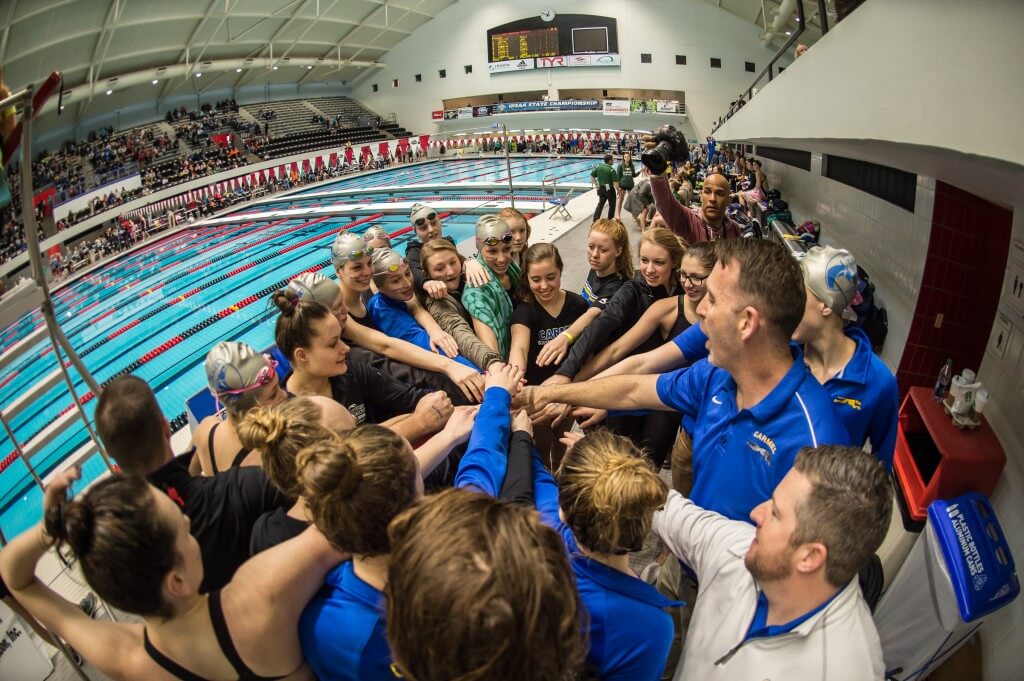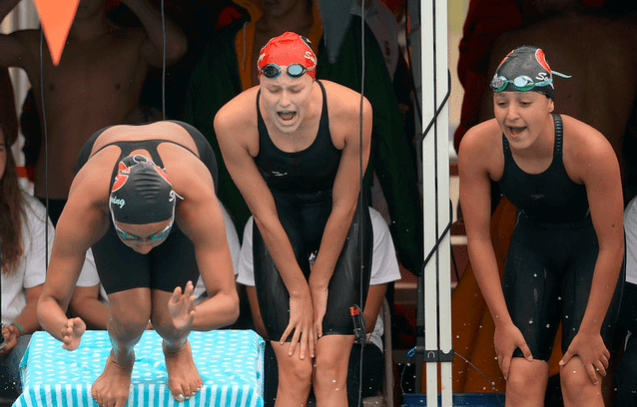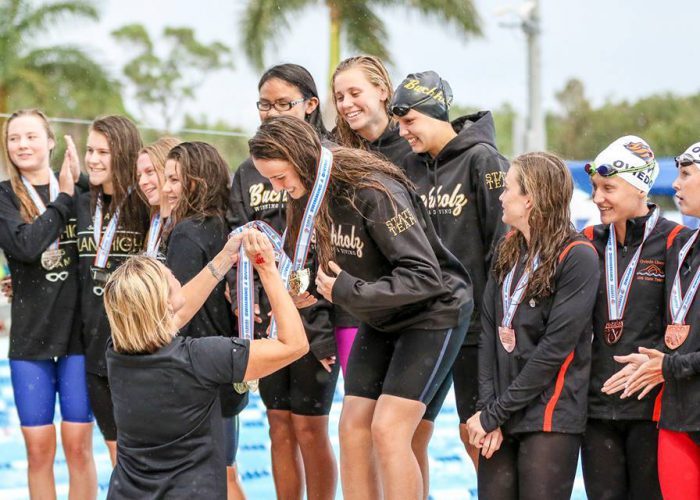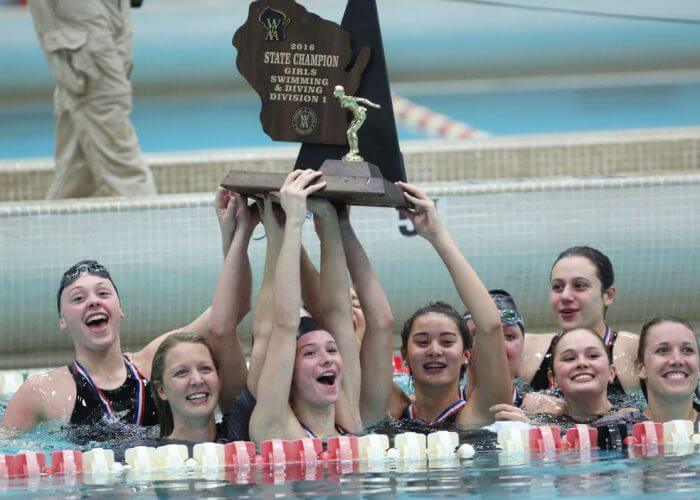How High School Swimming Prepares Swimmers for College Swimming

By Courtney Mykkanen, Swimming World College Intern.
As club swimmers may have noticed, high school swimming can be very different compared to year-round club swimming. While both have their advantages, they each play a part in preparing athletes for the college swimming environment. When evaluating high school and college swimming, there tend to be many similarities that actually benefit the year-round club swimmer in addition to the club’s preparation. While every club team and high school team operate differently, here is a case for how high school swimming prepares swimmers for the college swimming environment.

Photo Courtesy: Keith Birmingham/ Pasadena Star-News
High school swimming tends to be more team-oriented, while club swimming is more focused on the individual’s goals. Club focuses heavily on individual performance, whereas high school teams aim to beat the other teams in dual meets and throughout the season. College swimming is the same way; it’s about bringing everyone together, expecting everyone to put in their best effort and see the team’s end result. Many high school and college teams set specific individual and team goals that are centered on bettering the team as a whole and contributing towards reaching that team goal.
Setting team goals on club is a little different. Club teams can be very diverse in ages, sizes, and might even use multiple pools, making it difficult to get everyone on the same page. While clubs still might make team goals – such as scoring the most points at Junior Nationals – high school swimming team goals often reflect similar desired outcomes of college teams.
Relays at every meet are also a central part of the high school and college swimming season. Relays are always fun to participate in and play a major role in overall team scores. If the scores between two teams in a dual meet are very close, often it will come down to the last relay. This makes for an exciting showdown and intense rivalries!
High school swimming offers many new perspectives and support systems through new teammates and coaches. High school coaches may tell you something about your stroke you had never thought about in addition to different competition than you might be used to. This can be beneficial in keeping an open mind as the transition to a completely new college environment approaches.
High school swim teams are typically part of a league with other local teams, while college teams are part of conferences with other universities that usually require traveling for competitions. These leagues and conferences are based on many factors including school population, geographical location and swimming level.

Photo Courtesy: Florida Swim Network
November 2016
Dual meets are central to both high school and college swimming, as these can show a swimmer’s progression throughout the season. These meets typically take place with teams in the same league or conference with maybe one or two outside teams. On the other hand, it is uncommon for club teams to have dual meets against each other due to the varying factors of size, age, location and level. The preparation and experiences involved with dual meets during the high school swimming season better reflect the dual meet aspect of college swimming.
In high school swimming, it is important for team members to help strategize and evaluate the strengths and weaknesses of the opposing team. This is crucial in trying to beat other teams in high school or college dual meets. Learning how to compare the abilities of the opposing team with one’s own team will benefit swimmers in being able to prepare for college dual meets. Club swimming differs in that meets are often based on qualifying time standards rather than looking out for the competition.
Formulating a strategic dual meet line up is crucial to beating the other teams in the league or conference for high school and college competition. Once the strengths and weaknesses of both teams are weighed, the coach and team can predict whether there will be a clear win or loss or if it will be a close competition. These line ups often require a lot of thought and preparation, such has looking up the opposing team’s past meet results. Based on the line up in a high school swim meet, a club swimmer might have to swim the same events week after week or possibly swim an “off” event to bring up the team’s weakness. Getting swimmers comfortable with competing in the same events or “off” events benefit them for college swimming, as these same strategies are used. Club swimming differs because competitions are usually not weekly; instead, they are typically more spread out.

Photo Courtesy:
Amber Arnold, Wisconsin State Journal
The high school swimming season is similar to the college swimming season with the end-of-season championship meets. Typically, high school will have a league meet with all the teams they raced during dual meets, while college swimming has their conference championships. At these meets, swimmers can qualify for a higher-level meet and continue their season. While high school swimming ends with a state meet consisting of the best swimmers from that state, college swimming ends with the national championships where the best swimmers across the country in the same division compete.
Club swimming is crucial for swimmers to perform at their highest potential during both the club and high school seasons, and participating in high school swimming involves aspects similar to those found in college swimming. High school swimming is also fun and all club swimmers should participate during high school season if they have the opportunity!
All commentaries are the opinion of the author and do not necessarily reflect the views of Swimming World Magazine nor its staff.




Totally agree with this. My high school didn’t have a team and it took me a while to adapt to the school dynamic part of swimming.
Also agree with most of the story concepts. It’s too bad club coaches are discouraging their high school age swimmers from joining their high school team. College coaches should love to work with swimmers who swam in high school. Another plus is the advantage of working with different coaches which is why swim camps are great. Varied coaches and varied swimmers
My daughter participated in the school team last year and it made her so sick and ruined the rest of her club year. The required practices were so onerous in time but not value. She had to keep participating full time with her club team in order to get decent workouts. Her HS coach requires over double the time commitment of the other HS team in our town. From talking to other club members around the state I found they were able to practice mainly with their club and only go to HS practice the day before dual meets. I would love to know what other people have experienced??
I am so sad that this will preclude my daughter from participating again this year. She loved competing with the school team.
Doesn’t help when the high school team deliberately exclude year round swimmers from captainships and awards creating a clear division just so the non-club swimmers can feel important. Obviously this doesn’t happen at every school but very noticeable when it does. The coaches do a fantastic job at fostering a team spirit it’s just a shame that the booster clubs have ulterior motives.
It’s both fortunate and unfortunate that my sons high school doesn’t have any sports his districted school coach is great and it’s a shame the country doesn’t allow my son to participate at his districted school just for the fun as we are not worried about scouts etc it would have been my sons version of summer league no pressure just fun however the booster club was managed in part by some very jealous parents so glad we don’t have to deal with them.
How swimming helps you swim after swimming….
Or not
It doesn’t….at least where I’m located
As a swimmer way back in the dinosaur AAU days of swimming (graduated from Salesianum HS in Delaware 1974) we were forbidden by the DE high school association of swimming in AAU meets during the HS season. Sadly most of the better swimmers stayed with Bob Mattson and WAC, never got the HS experience and the HS State Meet was somewhat rinky-dink. It took the State Legislature to get involved in the 80’s to force the high school association to allow students to do both.
Of course there remain many inequities across the nation where way too many athletes are forced to make similar decisions as we did nearly fifty years ago. I know we are very blessed here in the great State of Florida where (for the most part) club and high school coaches work in concert for the best interest of the athlete.
Thanks for writing this Courtney – it definitely highlights some very positive aspects of representing your school – something every high school aged athlete can benefit from. Now if we can only get the adults to play together